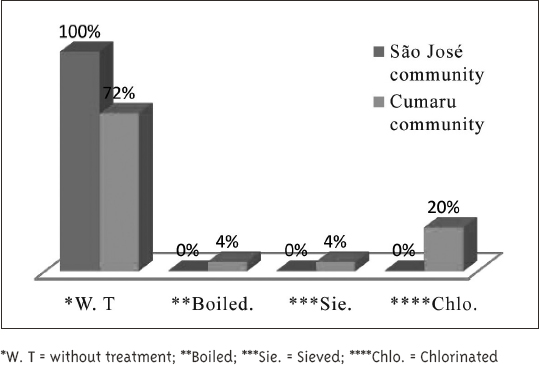Abstract
This article aims to analyze and understand the relationship between water and health in rural communities located in the watershed of Cumaru stream, in the municipality Igarapé-Açu, Northeast of Pará state. The harvesting and treatment of the water conducted by the rural population for human consumption were assessed, considering their practices of sanitary sewer, since these aspects have direct impact on their health. This study is based on field research with a quantitative approach. Closed questionnaire was used to raise the sources of water harvesting, rural sanitation, and use of agricultural inputs. We used participant observation, when focusing on the functioning of the agricultural establishment, to observe from various angles the relationship between water and health. We noted that the vulnerability of the water resources accessed by the population is a factor that contributes to the contamination of the sources, therefore a threat to the health of the rural population. However, the perception of the population is notable regarding deeper water sources, such as tube wells, which are priorities for water harvesting.
Keywords:
Water Resources; Basic Sanitation; Family Farm
Introduction
In Brazil, the Amazon region22According to IBGE, the Amazon region has the largest rainforest on the planet and covers the states of Acre, Amapá, Amazonas, Pará, Rondônia, Roraima, and parts of Maranhão, Tocantins, and Mato Grosso. is privileged when it comes to treating water. Rebouças (2004REBOUÇAS, A. Uso inteligente da água. São Paulo: Escrituras, 2004.) stress that Brazil figures in the classification as the richest country in water resources, and that, disproportionately to the population distribution, the Amazon watershed region has 73% of the total of discharges of the Brazilian rivers. However, the abundance of the resource is not always related to water quality, if considered the precariousness of the public water supply and sanitary sewer, since certain areas do not offer this service, as well as a great part of the countryside. Urban areas of big cities such as Belém resent the precariousness of basic sanitation (Trata Brasil, 2012TRATA BRASIL. Belém entre os dez piores índices de saneamento básico do Brasil. 6 fev. 2012. Disponível em: <Disponível em: http://www.tratabrasil.org.br/belem-entre-os-dez-piores-indices-de-saneamento-basico-do-brasil-nied-formacao-online >. Acesso em: 1º set. 2015.
http://www.tratabrasil.org.br/belem-entr... ).
In Brazil, only 32.8% of the households in rural areas are connected to water supply networks with or without indoor plumbing (Brasil, 2011bBRASIL. O desafio de universalizar o Saneamento Rural. FUNASA Notícias, Brasília, DF, dez. 2011b. Disponível em: <Disponível em: http://www.funasa.gov.br/site/wp-content/files_mf/blt_san_rural.pdf >. Acesso em: 16 ago. 2015.
http://www.funasa.gov.br/site/wp-content... ). In the Amazon region as a whole, less than 20% of households are connected to sewage systems. One likely effect of this is that, according to estimates, most of the sources of water harvesting for human consumption is contaminated with pollutants of various kinds, from human feces to heavy metals (Couto; Castro; Marin, 2002COUTO, R. C.; CASTRO, E. R.; MARIN, R. A. (Org.). Saúde, trabalho e meio ambiente: políticas públicas na Amazônia. Belém: NAEA, 2002.; Lisboa, 2002 apud Silva, 2006SILVA, H. P. A saúde humana e a Amazônia no século XXI: reflexões sobre os objetivos do milênio. Novos Cadernos NAEA, v. 9, n. 1, p. 77-94, 2006.).
According to the National Survey by Samples on Domicile (IBGE, 2012IBGE - INSTITUTO BRASILEIRO DE GEOGRAFIA E ESTATÍSTICA. Pesquisa Nacional por Amostra de Domicílios: 2012. Rio de Janeiro: IBGE, 2012. v. 32.), 67.2% of the rural population harvest water from fountains and wells protected or not, from water courses without any treatment, and from other generally unhealthy sources. In the Amazon region, 17.5% of rural households have sewage collection linked to general network, and 25.3% have septic tank, linked or not to the collecting network. The rudimentary cesspits and other solutions are adopted by 48.6% and 8.0% of the rural households, respectively. We highlight that these solutions are inadequate for the destination of the waste, such as the rudimentary cesspits, ditches, sewage disposal in natura directly into watercourses (Brasil, 2011bBRASIL. O desafio de universalizar o Saneamento Rural. FUNASA Notícias, Brasília, DF, dez. 2011b. Disponível em: <Disponível em: http://www.funasa.gov.br/site/wp-content/files_mf/blt_san_rural.pdf >. Acesso em: 16 ago. 2015.
http://www.funasa.gov.br/site/wp-content... ).
The chaotic scene of sanitary sewer33Treatment of solid and liquid waste. and public water supply in rural areas reflects the potential risks to the health of the population. In rural areas it is common to find women who spend several hours a day carrying water for the consumption of their families, and despite great efforts, the water obtained is not always suitable for consumption. Transport and storage conditions affect water quality, offering risks to the health of the population (Brasil, 2011bBRASIL. O desafio de universalizar o Saneamento Rural. FUNASA Notícias, Brasília, DF, dez. 2011b. Disponível em: <Disponível em: http://www.funasa.gov.br/site/wp-content/files_mf/blt_san_rural.pdf >. Acesso em: 16 ago. 2015.
http://www.funasa.gov.br/site/wp-content... ).
Coincidentally, the Amazon region has the highest proportions of spending on hospitalizations by diseases related to inadequate environmental sanitation (Trata Brasil, 2010aTRATA BRASIL. Esgotamento sanitário inadequado e impactos na saúde da população. 2010a. Disponível em: <Disponível em: http://www.tratabrasil.org.br/novo_site/cms/templates/trata_brasil/files/esgotamento.pdf >. Acesso em: 20 ago. 2015.
http://www.tratabrasil.org.br/novo_site/... ). The effects of sanitation on the health and quality of life of the population are extensive, which results in a higher cost to the municipal, state, and federal agencies with hospitalization, medicines, and medical assistance to the population.
Instituto Trata Brasil, when analyzing the incidence of gastrointestinal infections in the Country in cities with more than 300 thousand inhabitants, as well as the age range of incidence of these diseases and considering the Datasus data, we verified that in 2009 more than 462 thousand hospitalizations were notified across the Country for gastrointestinal infections. About 210 thousand cases were classified by doctors as diarrhoea and gastroenteritis of presumed infectious origin, little more than 10 thousand cases such as amebiasis, shigellosis, cholera and 246 thousand as “other intestinal infectious diseases” (Trata Brasil, 2010aTRATA BRASIL. Esgotamento sanitário inadequado e impactos na saúde da população. 2010a. Disponível em: <Disponível em: http://www.tratabrasil.org.br/novo_site/cms/templates/trata_brasil/files/esgotamento.pdf >. Acesso em: 20 ago. 2015.
http://www.tratabrasil.org.br/novo_site/... ).
Most hospitalizations occurred in the Amazon and Northeast regions - coincidentally, the regions with less access to sanitary sewer. In the Amazon region, 17% of the hospitalizations were recorded, an extremely high participation, considering the share of Brazilians who live in the region. The incidence rate is 5.25 cases per one thousand inhabitants per year, a value of 2.2 times higher than the national average and 6.3 times higher than the incidence in the Southeast region. It is noteworthy that the Amazon region has the most intense sanitation relative deficit of the country, in which 88% of households do not have sewage collection (Trata Brasil, 2010aTRATA BRASIL. Esgotamento sanitário inadequado e impactos na saúde da população. 2010a. Disponível em: <Disponível em: http://www.tratabrasil.org.br/novo_site/cms/templates/trata_brasil/files/esgotamento.pdf >. Acesso em: 20 ago. 2015.
http://www.tratabrasil.org.br/novo_site/... ).
The lack of treated water and sanitary sewer in rural areas endanger not only the health of farmers, but the population in general, since all the food is provided by the countryside. Family farm, consisting of small and medium-sized producers, represents the largest part of rural producers of Brazil, being responsible for 60% of the supply of basic products of the Brazilian diet, such as rice, beans, corn, vegetables, cassava and others.
The origin of the water used in agriculture - whether for irrigation or for food hygiene - is an object of concern, since diseases such as gastroenteritis, giardiasis, amebiasis, typhoid fever, infectious hepatitis, cholera, and worms are contracted by the intake of contaminated food and water, mainly by the absence of sanitary sewer (Trata Brasil, 2010aTRATA BRASIL. Esgotamento sanitário inadequado e impactos na saúde da população. 2010a. Disponível em: <Disponível em: http://www.tratabrasil.org.br/novo_site/cms/templates/trata_brasil/files/esgotamento.pdf >. Acesso em: 20 ago. 2015.
http://www.tratabrasil.org.br/novo_site/... ).
The official data and the literature available focus on urban spaces, generalizing or extrapolating the information to rural areas, assuming that the indexes are worse, since the formal treatment with chlorine is little used, in addition to the water treatment, which, if existent, does not always meet the established standards. This article aims to analyze and understand the relationship between water and health in rural communities located in the watershed of Cumaru stream, in the municipality Igarapé-Açu, Northeast of Pará. Communities are constituted by family farmers who produce and supply fruits and vegetables to the markets and fairs of the city and of the capital, Belém. However, problems related to water quality in this watershed have been detected by various authors and assigned to agricultural management, including the use of fire to prepare the planting area and the use of agrochemicals in general (Costa; Figueiredo; Silva, 2008COSTA, F. F.; FIGUEIREDO, R. O.; SILVA, M. G. M. Efeitos do uso da terra na biogeoquímica fluvial da microbacia do igarapé Cumaru, Nordeste do Pará. In: SEMINÁRIO SOBRE AGRICULTURA SEM QUEIMA COM BASE NO MANEJO DE CAPOEIRA, 2., 2008, Belém. Anais… Belém: Embrapa Amazônia Oriental, 2008.; Figueiredo, 2009; Lima; Souza; Figueiredo, 2004LIMA, L. M.; SOUZA, E. L.; FIGUEIREDO, R. O. Análise do risco de contaminação das águas subterrâneas por agrotóxicos na microbacia hidrográfica do igarapé Cumaru - Município de Igarapé-Açu (PA). In: CONGRESSO BRASILEIRO DE ÁGUAS SUBTERRÂNEAS, 13., 2004, Cuiabá. ISSN 2179-9784. Cuiabá: ABAS, 2004.; Wickel, 2004).
The interest in studying the communities of Cumaru and São José arose because both of them lie in a watershed where problems were detected; because of their structural conditions, such as the absence of public supply, which requires the harvesting of water from springs, streams, and shallow wells, in addition to the absence of sanitary sewer, prevailing the precarious structures of rudimentary cesspits in agricultural establishments.
The intention was to describe how the rural population is harvesting and treating water for human consumption, considering the sanitary sewer practices carried out by the people who live in the watershed, since these practices have implications on the health of the local population. This description brings the question about the degree of water quality and what actions could be adopted to reduce or control the degree of morbidity.
Methodological procedure
Characterization of the study area
The municipality of Igarapé-Açu is located in Northeast of Pará state, region that houses 49 municipalities, distributed in five watersheds: Bragantina, Cameta, Guama, Salgado, and Tome-Açu (IBGE, 2012). Igarapé-Açu belongs to the microregion Bragantina and is 110 km away from the capital of Pará, delimited on the north by the municipalities of Maracanã and Marapanim; on the south by the municipality of Santa Maria do Pará; on the east by the municipality of Nova Timboteua; and on the west by the municipalities of Castanhal and São Francisco do Pará34IBGE – INSTITUTO BRASILEIRO DE GEOGRAFIA E ESTATÍSTICA. Censo demográfico 2010. Disponível em: <www.ibge.gov.br>. Acesso em: 10 dez. 2014..
Northeast of Pará is characterized as the oldest settlement area of the Amazon. This historical fact contributed to intense exploitation of its natural resources, such as vegetable extraction (wood in logs, firewood, and coal) and agriculture, with the plantation of subsistence crops, fruit trees, malva, black pepper, coconut, palm oil, cattle and bubalus rearing (Baena; Falesi; Dutra, 1998BAENA, A. R. C.; FALESI, I. C.; DUTRA, S. Características físico-químicas do solo em diferentes agroecossistemas da região Bragantina do Nordeste Paraense. Belém: Embrapa CPATU, 1998.).
According to the IBGE, in 2010, the municipality of Igarapé-Açu had 35,887 thousand inhabitants, 12,983 lived in the rural area of the municipality. Holder of an area of 786 km², the municipality is the 47th city in territorial extension, with population density of 39,12 inhabitants/km5.
The municipality of Igarapé-Açu emerged with the creation of Bragança Railway Station, initiated on 23 June 1883. For Freitas (2005FREITAS, A. M. Memória de Igarapé-Açu. Belém: Supercores, 2005.), Bragança Railway Station was essential in the settlement process that happened in Northeast of Pará, being created for Igarapé-Açu an expansionist occupation pattern.
Igarapé-Açu is a Tupi word meaning “big stream” or “way of the canoes.” There is another translation rooted in the imaginary about the waters as the path of the lord or of the lady of waters (Freitas, 2005FREITAS, A. M. Memória de Igarapé-Açu. Belém: Supercores, 2005.). The name given to the municipality is related to the watercourse called Igarapé-Açu, right tributary of the river Marapanim, which receives by the right margin streams of greater importance, such as Pau Cheiroso, Do Colono, and Santa Rita.
The municipality is delimited topographically by a watershed drained by the Maracanã river, whose extension is about 50 km (Vanzin, 2014VANZIN, M. M. Avaliação do uso sustentável da água na produção agrícola: impacto da inserção de sistemas agroflorestais em unidades produtivas familiares do Nordeste Paraense. 2014. Dissertação (Mestrado em Agriculturas Familiares e Desenvolvimento Sustentável) - Universidade Federal do Pará, Belém, 2014.), receptor of several watersheds, among which is the Cumaru stream, locus of the study.
The watershed of Cumaru stream features an area of 4,127.34 ha. It is located between the geographical coordinates 1°12’00” and 1°16’00” latitude south and 47°32’00” and 47°34’00” longitude west of the meridian of Greenwich (Silva et al., 2009SILVA, H. P. A saúde humana e a Amazônia no século XXI: reflexões sobre os objetivos do milênio. Novos Cadernos NAEA, v. 9, n. 1, p. 77-94, 2006.). The watershed hosted international studies such as the project Studies of Human Impacts on Forests and Floodplains in the Tropics (SHIFT), among others, and since 2013 it has been the research subject of the Empresa Brasileira de Pesquisa Agropecuária (Embrapa) and partner institutions, which have developed in the field research related to the project “Monitoramento e caracterização quali-quantitativa dos recursos hídricos e sua relação com o uso da terra em bacias experimentais nos diferentes biomas brasileiros”.
The research already carried out in the watershed were very important for the knowledge of their water resources and development of agricultural practices in the context of family farm. However, the theme of rural health was not addressed. Thus, this study will provide the knowledge about rural health of the region, also intending to assist the public power in decision making to help the farmers.
Collection point
This research was developed based on bibliographic and documentary surveys and participant observation in rural communities located in the watershed of Cumaru stream, Igarapé-Açu, PA. These communities are named as Cumaru and São José, being their location presented in Figure 1.
The communities studied are differentiated by the number of inhabitants and by the territorial extension, Cumaru is the most extensive and populous one, housing around 105 families, distributed in 12 km of extension. The São José community houses 32 families, according to the surveys carried out with community health agents (CHA).
A minimum of 50% of the population of each community entered the study, and questionnaires containing 22 closed questions were applied, to collect information about the structure of agricultural establishments concerning rural sanitation. Interviews were not directed (Michelat, 1987MICHELAT, G. Sobre a utilização de entrevista não diretiva em sociologia. In: THIOLENT, M. Crítica metodológica, investigação social e enquete operária. 5. ed. São Paulo: Polis, 1987. p. 191-212.) with actors considered crucial for this study, such as a doctor, a nurse, a public health department director, CHA, and other local actors. As a way to preserve the identity of respondents, they are identified in the text by numbering or labor occupations. The concentration of residencies was chosen to conduct the interviews, because, as they were agglomerated, contamination of water sources are more prone to happen.
This was followed by the strategy adopted by Galizoni (2005GALIZONI, F. M. Águas da vida: população rural, cultura e água em Minas Gerais. 2005. Tese (Doutorado em Ciências Sociais) - Instituto de Filosofia e Ciências Humanas, Universidade Estadual de Campinas, São Paulo, 2005.), in which the method of traversing the agricultural establishment with family members would provide the observation by various angles of the multiple use of water. Thus, we considered that it would be useful to know the sources of water present in the establishment, the physical structures that surround them and the perception of users about these sources.
We chose to observe the structure of the agricultural establishments to understand how the families are distributed, since it was noticeable the concentration of residencies in the same establishment. According to the CHA, 43% of farmers from São José community are partners/sharecroppers (P/S) in the conditions of land ownership.
In the Cumaru community, 74% of farmers Cumaru are P/S on land ownership. The significant percentage of farmers who share the same agricultural establishment is given by virtue of the size of families, usually with parental proximity of 1st and 2nd degree, being common to find couples of cousins or of other degree of kinship that constituted family, remaining in the family agricultural establishment.
Although the agricultural establishments are characterized by the presence of several houses, each resident has a certain space on the lot for the cultivation of cassava (Manihot esculenta Crantz) or other crops. Although the planting spaces and household are demarcated, when it comes to water, there is no limitation to the use of the resource. The sources of water such as streams, springs and wells are of common use for families, whether for agriculture, animals, domestic or consumption activities.
Although the sharing of water sources occurs without restriction to families, the orientation for the sharing of water among the communities studied is different, because in the São José community, sources are released for use with the following condition: There can be no fight over water.
According to the Respondent 1, farmer and one of the first residents of the São José community, the well gives the following guidance:
You can get the amount of water you want, I just don’t want anything “nasty” in the well. My father used to say [that] who denied water would die thirsty! Anyone can get water, it’s my pleasure, I just don’t want they fighting over it, because people say that when that happens, the well dries. God gave me water, well then, I give to everyone (Respondent 1).
The Respondent 1 reports that, despite not having a lot of trouble with water today, as residents paid to build tube wells - and with plumbing, the water is shared with other residences - there was a time when everyone got water only from streams on the edge of the road. According to Graph 1, in the São José community, 60% of respondents said they shared water sources with a maximum of five families. The 33% who said not to share water are the most isolated residents, no other residences are located in the agricultural establishment.
Of the total respondents in the Cumaru community, 50% said they shared water sources with a maximum of five families, but some sources are shared by a larger number, i.e., 13% of farmers reported to share water with a maximum of ten families, while those who do not share are 37% and normally have only wide wells, being dug in private properties or in isolation in the agricultural establishment.
We highlight the attitudes of farmers in São José community, who receive water from a neighbor. They expressed concern about the increase in the energy bill of the resident who provides water. They seek to regulate their use, prioritizing water consumption in household activities, as for washing clothes they use the stream, because this activity requires more water and, therefore, more power. This fact is associated with water sources that are shared, because in the São José community, the tube wells are the shared source, while in the Cumaru community, the shared source are the wide wells and streams.
The sharing of water sources occurs in both communities; since they do not have the public supply of this resource, the farmers are responsible for the harvesting, storage, and treatment of water for consumption and other activities.
The clusters of residencies and free access to water sources in the communities are factors that contribute to the contamination of the sources, which occurs because of the precariousness of basic sanitation, lack of public water supply, and sanitary sewer.
In the absence of sanitary sewer, farmers improvise poor structures, such as rudimentary cesspits consisting of holes dug with three to four meters deep by one or two meters in width and/or length, without internal protection, which causes concern, since the rural population gets water from shallow wells with depths ranging from six to twelve meters mostly in sandy soils. According to the study by Lima, Souza and Figueiredo (2004LIMA, L. M.; SOUZA, E. L.; FIGUEIREDO, R. O. Análise do risco de contaminação das águas subterrâneas por agrotóxicos na microbacia hidrográfica do igarapé Cumaru - Município de Igarapé-Açu (PA). In: CONGRESSO BRASILEIRO DE ÁGUAS SUBTERRÂNEAS, 13., 2004, Cuiabá. ISSN 2179-9784. Cuiabá: ABAS, 2004.), in the watershed of Cumaru stream, the population is supplied by shallow wells and surface water, which makes the water supply vulnerable to contamination. Pessoa et al. (2010PESSOA, M. C. Y. et al. Avaliação do potencial de riscos de contaminação de águas superficiais e subterrâneas por agrotóxicos aplicados na cultura do maracujá-amarelo na microbacia hidrográfica do igarapé Cumaru, estado do Pará. In: GOMES, M. A. F; PESSOA, M. C. P. Y. (Org.). Planejamento ambiental do espaço rural com ênfase em microbacias hidrográficas: manejo de recursos hídricos, ferramentas computacionais e educação ambiental. Brasília: Embrapa Informação Tecnológica, 2010. p. 201-225.) highlight that the risk of groundwater contamination by some pesticides is high in passion fruit cultivation in family farms from this watershed, according to the application of mathematical model.
Comparing the types of sanitary sewer adopted by the communities, one realizes that rudimentary cesspits prevail. According to the Graph 2, 67% of the farmers of São José community use rudimentary cesspits. It is likely to occur an infiltration of waste, contaminating the underground sheets. We noted that 33% of those who adopted the septic tanks still resist to innovation, keeping the rudimentary cesspit in the establishment.
The same occurs in the Cumaru community, in which 64% of respondents said that they use the rudimentary cesspit for sanitary sewer, and the other 30% who use septic tank also maintain the cesspit in the establishment.
Respondent 2, Cumaru community: Here we have the [septic] tank, the bathroom is indoors, the tank is over there in the fence [20 m from the residence].
Researcher: But what about that little house near the fence?
Respondent 2: Oh, that’s the toilet [rudimentary cesspit], it’s new, we can’t live without it, we change it, cover, and build another [...].
Researcher: Which one do you prefer?
Respondent 2: People from the farm, like us, prefer this one [rudimentary cesspit].
In both communities, rudimentary cesspits are not seen as a threat of contamination and it is assumed that their vulnerability to contamination of water sources by these pathways is a real threat to the health of the local population.
According to data from the World Health Organization, 80% of cases of diarrheal diseases are caused by the unsanitary water supplies, inadequate sewage, and poor hygiene. Improved water supply reduces between 6% and 21% its morbidity; improved sanitary sewer reduces its mortality in 32%; hygiene measures can reduce the number of cases up to 45% and, lastly, improved water quality for consumption, by means of its domestic treatment, can reduce from 35% to 39% the cases of this disease (Trata Brasil, 2010bTRATA BRASIL. Benefícios econômicos da expansão do saneamento brasileiro. 2010b. Disponível em: <Disponível em: http://www.tratabrasil.org.br/novo_site/cms/files/trata_fgv.pdf >. Acesso em: 16 ago. 2016.
http://www.tratabrasil.org.br/novo_site/... ).
The incidence of waterborne diseases is related to the absence of treatment intended for water consumption, which is related to the perception of the water quality by its users. This fact causes concern, since the farmers from the communities studied did not know the drinkability of the resource, associating quality and drinkability by only considering aspects of color, smell, and taste. For the Brazilian Ministry of Health, drinking water must meet microbiological, physical, chemical, and radioactive parameters (Brasil, 2011aBRASIL. Ministério da Saúde. Portaria nº 2.914, de 12 de dezembro de 2011. Dispõe sobre os procedimentos de controle e de vigilância da qualidade da água para consumo humano e seu padrão de potabilidade. Diário Oficial da União, Brasília, DF, 12 dez. 2011a. Disponível em: <Disponível em: http://bvsms.saude.gov.br/bvs/saudelegis/gm/2011/prt2914_12_12_2011.html >. Acesso em: 10 ago. 2015.
http://bvsms.saude.gov.br/bvs/saudelegis... ).
According to Graph 3, in São José community, 67% of the farmers claimed that the water is of good quality, while 27% think that it is not suitable for consumption, although there are no alternatives, and 6% of the farmers said that the water is suitable for consumption only in the summer66We live in a state cut by the line of Ecuador, thus with lands in the northern hemisphere (lower part) and in the southern hemisphere. Equatorial climate with two very different periods during the year, a rainy one, starting in December, and a dry one, starting in June.. The farmers’ perception about the water quality for ingestion is associated with aspects such as color, smell and taste, as well as the depth of the well from which the water is harvested.
To exemplify we can use the 6% of respondents who said that the water is suitable for consumption in the summer, i.e., they harvest water from shallow wells or springs in the summer. During the winter, the shallow wells or springs are flooded by the rain, which restrain the time to harvest water to, usually, before the rain. During the open interview, the association color, smell and taste with the water quality was unanimous.
Respondent 3, from São José, harvests water to drink from a wide well of six meters deep, and describes with pride the water she drinks:
Now they are forbidding us to drink water from the stream, but we don’t need to drink that water, there’s a well here and the water is bright white. My well has never gotten dirty, it has a good, clean water and has never dried” (Respondent 3).
By the last sentence we can assume that the well supply is another element associated with the quality of the source.
In the Cumaru community, 72% of farmers claimed that the water is suitable for consumption, considering color, smell and taste; 2% said that the water is not of good quality, as it has a taste of root or rust; and the 26% who claimed that the water quality was partial, associated quality with the dry and rainy weather, as it can change color, smell, and taste.
Unlike the São José community, the depth of the water source is not associated with the water quality, but with the sources where the water is harvested for consumption, whereas in the São José community, 53% of farmers harvest water from tube wells, because they believe that the larger the depth of the well, the safer will be the water for consumption. However, the 27% that harvest water to drink from the wide well, built lateral and surface protections to prevent the entry of insects and other vectors of contamination, but stated that they would like to receive treated water in their homes, as well as the 20% that harvest water from springs.
The farmers who harvest water from springs are satisfied with its quality, but the distance between the source and the residence is the factor that motivates the desire to receive public water supply.
Compared with the São José community, Graph 4 shows that the population of the Cumaru community prefers wide wells, as 46% of respondents claimed to harvest water from this type of well. These wells, according to the open interviews, are on average from six to twelve meters deep. We call the attention for the 22% that harvest water from springs, since shallow water sources and the ones of free access are more susceptible to contamination than the deep or of restricted access ones.
Contaminations occur not only in water sources, but in its carbon capture and storage. During the observation field, we followed the routine of farmers that harvest water from springs: women create strategies to distribute the weight of the bottles with water and ensure more bottles filled in one “trip77Term used by to indicate the displacement toward the spring.” to the spring.
Figure 2 shows the procedure of harvesting and storage of water for drinking and cooking: two-liter plastic bottles are filled with water - strained with cloth to remove the solid matter in suspension - , subsequently allocated in the fridge. It is noteworthy the conception of treatment that farmers have, since all respondents claimed to treat water by removing the material in suspension with the aid of a strainer, usually a piece of cloth. Two epistemological fields conflict: on one side, the conception and knowledge of farmers, and on the other, what is recommended by the Brazilian Ministry of Health, such as the presence of free residual chlorine, at any point in the supply system, setting limits so the maximum content is 2.0 mg/L (Brasil, 2001BRASIL. Ministério da Saúde. Portaria nº 1.469, de 29 de dezembro de 2000. Estabelece os procedimentos e responsabilidades relativos ao controle e vigilância da qualidade da água para consumo humano e seu padrão de potabilidade, e dá outras providências. Diário Oficial da União, Brasília, DF, 10 jan. 2001.).
Despite the recommendations of the Brazilian Ministry of Health, how would the population that does not have public supply, such as the communities studied, be attended? What has been offered and oriented to farmers is the use of the chemical sodium hypochlorite, passed on by the Secretary of Health to rural health stations and distributed by CHA to farmers.
According to the nurse responsible for the communities of Cumaru and São José, five to six boxes containing 50 bottles of sodium hypochlorite are received monthly, which are distributed during the daily visits of the CHA and in medical appointments, held monthly in the communities.
The CHA claim that the population refuses to use this method of treatment, justifying that it changes the taste and smell of the water. During the open interview, we also noted the resistence of the farmers to use the sodium hypochlorite.
Some people when receive hypochlorite at home, use it to wash the house, clothes and other things, because if it is used in the water, husband and children complain.
The other day I filled the pot with water and put a few drops, when my husband came home, he shed all the water (Respondent 4, Cumaru community).
With the rejection of using sodium hypochlorite, we noted that people have been harvesting directly from water sources, removing only the material in suspension. Farmers who harvest water from springs, usually far from home, create strategies to improve the transport of a larger portion of water, by using instruments, such as handcarts, bicycles, and others (Figure 3).
Respondent 5 claimed to go to the spring at least twice a day. Traversing 500 meters from the residence to the spring, to store water for cooking, she carries twelve two-liter bottles and two buckets of 20 liters. The harvesting source (Figure 2) is used by five families, distributed in the agricultural establishment, all of them using it only to harvest water for drinking and cooking.
Five families live here, all of them get their supply from the spring and stream, but in the summer we have only the spring, everyone is aware that you can’t wash clothes there, it’s just for drinking, then one day all the ladies go to the bridge Cumaru to wash clothes. We, the ones who clean up the spring, always wake up early and go there, remove leaf, twigs and all the dirt, but it’s got to be early, so at the end of the afternoon we have water in the spring (Respondent 5, São José community).
In the Cumaru community, 22% of farmers drink spring water, and seem confident in its quality, despite being a source of free access to wild animals and others. Besides, they did not complain about the distance between the source and the residence. The farmer (Respondent 6) claimed to be used to that task, going at least four times a day to the spring to harvest water for cooking and drinking (Figure 4).
As the harvesting, transportation and distribution of water is the responsibility of the population, we noted some concerns about transportation and storage. For example, one can cite the reuse of containers from a source not recommended, such as packaging of fertilizers, inks, and others (Figure 5).
The absence or the precarious and inadequate treatment of water for consumption is associated with the use of inappropriate containers for reuse. When asked about what kind of treatment was given to the water, 100% of respondents in the São José community said that they do not treat the water for consumption. These data show the perception of significant quality and drinkability that farmers have on the water for consumption. The waters of light color (white) are suitable for consumption, and even though there is a focus of pollution near the harvesting source, the farmers do not associated it with the risk of contamination, which also occurs with symptoms of gastrointestinal diseases, not linked to the consumption of contaminated water.
In the Cumaru community we identified some forms of water treatment; 20% of the respondents affirmed to use chlorine as a treatment. The 4% who said they boiled the water to drink were with newborn children at home and thus adopted this measure of disease-prevention. Even identifying some forms of treatment, the percentage of people who do not treat the water for consumption corresponds to 72% of respondents.
The absence of water treatment has entailed the appearance of diseases such as giardiasis, amebiasis, and verminosis. According to the nurse responsible for the communities, the appearance of symptoms such as abdominal pain and diarrhea occurs more frequently during the rainy season, from January to March, since during this period the water sources such as springs and shallow wells are flooded by rainwater.
According to Amaral et al. (2003)AMARAL, L. A. et al. Água de consumo humano como fator de risco à saúde em propriedades rurais. Revista de Saúde Pública, São Paulo, v. 37, n. 4, p. 510-514, 2003., in the periods of rain, water fountains are susceptible to contamination as a result of the rapid percolation of microorganisms into the groundwater, allied to the fact that the level of the water during this period approaches the surface of the ground, lessening the filtering capacity. In addition, it is the period of supply of fruits, such as mango, for example. It is also a period of proliferation of insects such as flies, which contributes to the increase in gastrointestinal diseases transmitted by them.
The effect of gastrointestinal diseases reflects on the work of farmers, on the budget of families and on the health service offered by the municipality of Igarapé-Açu, since appointments are held only once a month, with a number limited to 40 people. If farmers cannot get an appointment held on the location, they need to commute to the municipal headquarters for a vacancy in the municipal hospital.
According to the nurse who works in the urban area, a participant of the family health strategy, the municipality of Igarapé-Açu has twelve health centers distributed in rural and urban areas of the municipality, as well as staffs composed of doctor, nurse, nursing technician, and CHA. These health centers have been created as a service strategy to the population, since the municipality stands out for its extensive rural and territorial dimension.
The municipality has the health surveillance, which monitors the water sources accessed by the rural population. However, the lack of staff is the greatest limitation to the development of effective actions in the field, as the director of the Health Department of Igarapé-Açu highlighted. Despite several limitations, to entrust the consumer himself to control the water quality is an incorrect conduct, since his knowledge about the risks that water can offer to health care is virtually non-existent (Amaral et al., 2003AMARAL, L. A. et al. Água de consumo humano como fator de risco à saúde em propriedades rurais. Revista de Saúde Pública, São Paulo, v. 37, n. 4, p. 510-514, 2003.).
Final considerations
According to Giatti (2007GIATTI, L. L. Reflexões sobre água de abastecimento e saúde pública: um estudo de caso na Amazônia brasileira. Saúde e Sociedade, São Paulo, v. 16, n. 1, p. 134-144, 2007.), to discuss the Amazon water is necessary to counteract and reevaluate the concept of availability of water resources in the Brazilian Amazon, especially regarding its provision of water resources. Although the region is known worldwide for its abundance in natural resources, particularly water, still is a challenge to ensure drinking water for the entire population. The biggest obstacles are the deficit in basic sanitation associated with the absence of monitoring of water sources.
The difficulty in having access to drinking water is linked to the precarious infrastructure and resource management, which shows the need for protection of rivers, the optimization of harvesting and treatment of water, and access to isolated populations, such as the rural population.
Despite the lack of structure in the access to water, the farmers use their perceptions to define the uses of water, according to each source. This can be exemplified by the access to the springs that arise on the ground, generally distant from the residence and family control, considered as suppliers of reliable sources of water by its physical characteristics (no smell, taste, and color). The aspects evaluated by the sensorial perception of consumers and technicians dealing with the matter show that the investment for the proper use of water passes through changes in perception and in social construction of what the conditions of hygiene are to ensure the health of the consumer. The wells (tube and wide) are ways to minimize the difficulty of the task to carry water taken from cacimbas (wells without casing), facilitating the access to water through installations close to the residencies. The streams seen as source of access to all residents are not suitable for consumption, being used for several activities, such as irrigation, washing of utensils, and personal hygiene.
Considering that the water is not evenly distributed - and in the absence of the competent bodies to regularize its supply -, farmers need to create strategies to ensure the supply. The cultural character of women carrying cans of water on their heads can be considered; however, the risk by the consumption of contaminated water is not considered. Prevention measures are necessary, either directly in the water source or in drinking water treatments, which may not be an easy task, both by the sight of managers and farmers, which equipped with a load of traditional knowledge, do not pay attention to the need for water treatment, and maybe that is why certain practices such as the use of the chemical sodium hypochlorite is refused. Informational and educational actions in schools, through courses, lectures, seminars and workshops, could promote a change in the behavior of the population toward hygienic improvement for the use of this resource.
References
- AMARAL, L. A. et al. Água de consumo humano como fator de risco à saúde em propriedades rurais. Revista de Saúde Pública, São Paulo, v. 37, n. 4, p. 510-514, 2003.
- BAENA, A. R. C.; FALESI, I. C.; DUTRA, S. Características físico-químicas do solo em diferentes agroecossistemas da região Bragantina do Nordeste Paraense. Belém: Embrapa CPATU, 1998.
- BRASIL. Ministério da Saúde. Portaria nº 1.469, de 29 de dezembro de 2000. Estabelece os procedimentos e responsabilidades relativos ao controle e vigilância da qualidade da água para consumo humano e seu padrão de potabilidade, e dá outras providências. Diário Oficial da União, Brasília, DF, 10 jan. 2001.
- BRASIL. Ministério da Saúde. Portaria nº 2.914, de 12 de dezembro de 2011. Dispõe sobre os procedimentos de controle e de vigilância da qualidade da água para consumo humano e seu padrão de potabilidade. Diário Oficial da União, Brasília, DF, 12 dez. 2011a. Disponível em: <Disponível em: http://bvsms.saude.gov.br/bvs/saudelegis/gm/2011/prt2914_12_12_2011.html >. Acesso em: 10 ago. 2015.
» http://bvsms.saude.gov.br/bvs/saudelegis/gm/2011/prt2914_12_12_2011.html - BRASIL. O desafio de universalizar o Saneamento Rural. FUNASA Notícias, Brasília, DF, dez. 2011b. Disponível em: <Disponível em: http://www.funasa.gov.br/site/wp-content/files_mf/blt_san_rural.pdf >. Acesso em: 16 ago. 2015.
» http://www.funasa.gov.br/site/wp-content/files_mf/blt_san_rural.pdf - COSTA, F. F.; FIGUEIREDO, R. O.; SILVA, M. G. M. Efeitos do uso da terra na biogeoquímica fluvial da microbacia do igarapé Cumaru, Nordeste do Pará. In: SEMINÁRIO SOBRE AGRICULTURA SEM QUEIMA COM BASE NO MANEJO DE CAPOEIRA, 2., 2008, Belém. Anais… Belém: Embrapa Amazônia Oriental, 2008.
- COUTO, R. C.; CASTRO, E. R.; MARIN, R. A. (Org.). Saúde, trabalho e meio ambiente: políticas públicas na Amazônia. Belém: NAEA, 2002.
- DA SILVA, B. N. R. et al. Solos das mesobacias hidrográficas dos igarapés São João e Cumaru, municípios de Marapanim e igarapé Açu. In: CONGRESSO BRASILEIRO DE CIÊNCIA DO SOLO, 32., 2009, Fortaleza. Anais… Fortaleza: SBCS, 2009.
- FREITAS, A. M. Memória de Igarapé-Açu. Belém: Supercores, 2005.
- GALIZONI, F. M. Águas da vida: população rural, cultura e água em Minas Gerais. 2005. Tese (Doutorado em Ciências Sociais) - Instituto de Filosofia e Ciências Humanas, Universidade Estadual de Campinas, São Paulo, 2005.
- GIATTI, L. L. Reflexões sobre água de abastecimento e saúde pública: um estudo de caso na Amazônia brasileira. Saúde e Sociedade, São Paulo, v. 16, n. 1, p. 134-144, 2007.
- LIMA, L. M.; SOUZA, E. L.; FIGUEIREDO, R. O. Análise do risco de contaminação das águas subterrâneas por agrotóxicos na microbacia hidrográfica do igarapé Cumaru - Município de Igarapé-Açu (PA). In: CONGRESSO BRASILEIRO DE ÁGUAS SUBTERRÂNEAS, 13., 2004, Cuiabá. ISSN 2179-9784. Cuiabá: ABAS, 2004.
- MICHELAT, G. Sobre a utilização de entrevista não diretiva em sociologia. In: THIOLENT, M. Crítica metodológica, investigação social e enquete operária. 5. ed. São Paulo: Polis, 1987. p. 191-212.
- IBGE - INSTITUTO BRASILEIRO DE GEOGRAFIA E ESTATÍSTICA. Pesquisa Nacional por Amostra de Domicílios: 2012. Rio de Janeiro: IBGE, 2012. v. 32.
- PESSOA, M. C. Y. et al. Avaliação do potencial de riscos de contaminação de águas superficiais e subterrâneas por agrotóxicos aplicados na cultura do maracujá-amarelo na microbacia hidrográfica do igarapé Cumaru, estado do Pará. In: GOMES, M. A. F; PESSOA, M. C. P. Y. (Org.). Planejamento ambiental do espaço rural com ênfase em microbacias hidrográficas: manejo de recursos hídricos, ferramentas computacionais e educação ambiental. Brasília: Embrapa Informação Tecnológica, 2010. p. 201-225.
- REBOUÇAS, A. Uso inteligente da água. São Paulo: Escrituras, 2004.
- SILVA, H. P. A saúde humana e a Amazônia no século XXI: reflexões sobre os objetivos do milênio. Novos Cadernos NAEA, v. 9, n. 1, p. 77-94, 2006.
- TRATA BRASIL. Esgotamento sanitário inadequado e impactos na saúde da população. 2010a. Disponível em: <Disponível em: http://www.tratabrasil.org.br/novo_site/cms/templates/trata_brasil/files/esgotamento.pdf >. Acesso em: 20 ago. 2015.
» http://www.tratabrasil.org.br/novo_site/cms/templates/trata_brasil/files/esgotamento.pdf - TRATA BRASIL. Benefícios econômicos da expansão do saneamento brasileiro. 2010b. Disponível em: <Disponível em: http://www.tratabrasil.org.br/novo_site/cms/files/trata_fgv.pdf >. Acesso em: 16 ago. 2016.
» http://www.tratabrasil.org.br/novo_site/cms/files/trata_fgv.pdf - TRATA BRASIL. Belém entre os dez piores índices de saneamento básico do Brasil. 6 fev. 2012. Disponível em: <Disponível em: http://www.tratabrasil.org.br/belem-entre-os-dez-piores-indices-de-saneamento-basico-do-brasil-nied-formacao-online >. Acesso em: 1º set. 2015.
» http://www.tratabrasil.org.br/belem-entre-os-dez-piores-indices-de-saneamento-basico-do-brasil-nied-formacao-online - VANZIN, M. M. Avaliação do uso sustentável da água na produção agrícola: impacto da inserção de sistemas agroflorestais em unidades produtivas familiares do Nordeste Paraense. 2014. Dissertação (Mestrado em Agriculturas Familiares e Desenvolvimento Sustentável) - Universidade Federal do Pará, Belém, 2014.
- 1Financed by the Coordination of Higher Education Personnel Training (CAPES).
- 2According to IBGE, the Amazon region has the largest rainforest on the planet and covers the states of Acre, Amapá, Amazonas, Pará, Rondônia, Roraima, and parts of Maranhão, Tocantins, and Mato Grosso.
- 3Treatment of solid and liquid waste.
- 4IBGE – INSTITUTO BRASILEIRO DE GEOGRAFIA E ESTATÍSTICA. Censo demográfico 2010. Disponível em: <www.ibge.gov.br>. Acesso em: 10 dez. 2014.
- 5IBGE – INSTITUTO BRASILEIRO DE GEOGRAFIA E ESTATÍSTICA. Censo demográfico 2010. Disponível em: <www.ibge.gov.br>. Acesso em: 10 dez. 2014.
- 6We live in a state cut by the line of Ecuador, thus with lands in the northern hemisphere (lower part) and in the southern hemisphere. Equatorial climate with two very different periods during the year, a rainy one, starting in December, and a dry one, starting in June.
- 7Term used by to indicate the displacement toward the spring.
Publication Dates
- Publication in this collection
Oct-Dec 2016
History
- Received
08 Dec 2015 - Reviewed
09 June 2016 - Accepted
19 July 2016


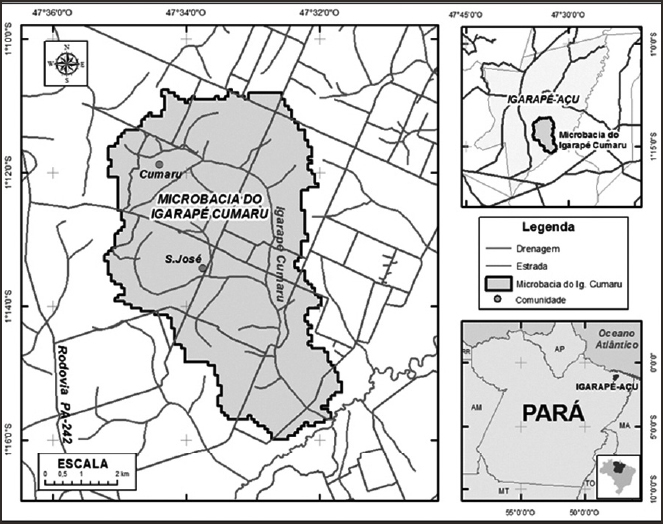 Source: Adapted from
Source: Adapted from 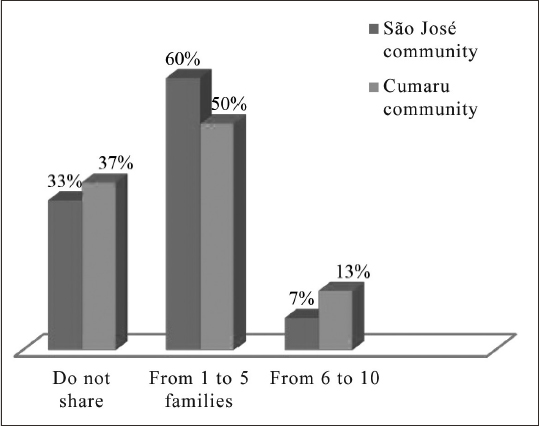
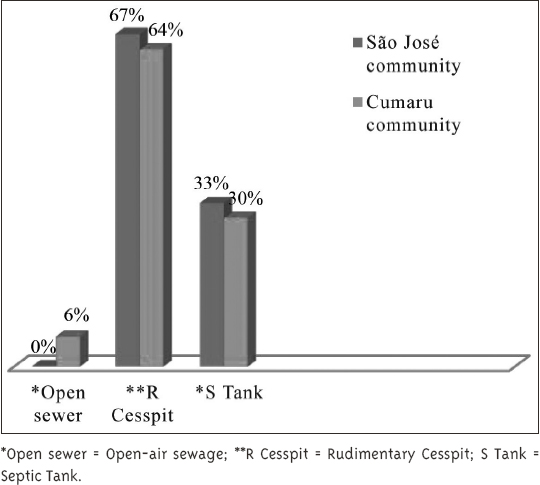
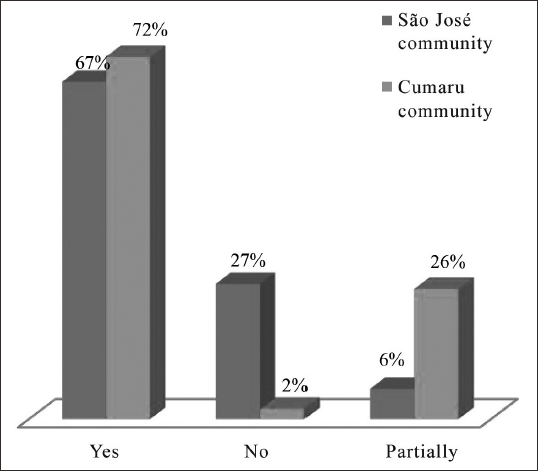
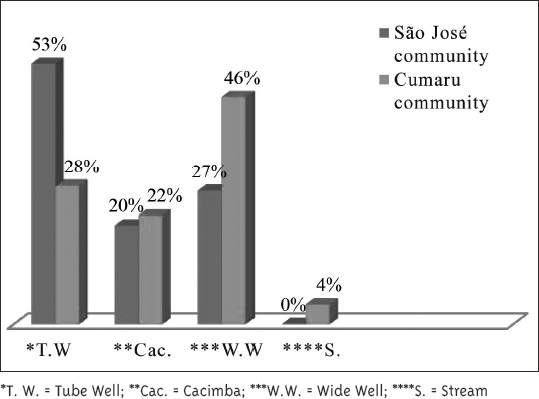
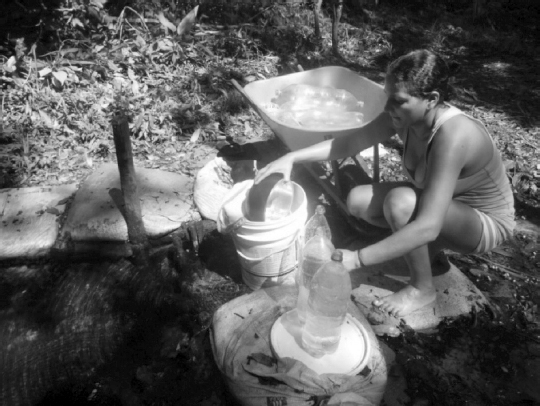 Source: Rafaela Sales de Sousa, 2015
Source: Rafaela Sales de Sousa, 2015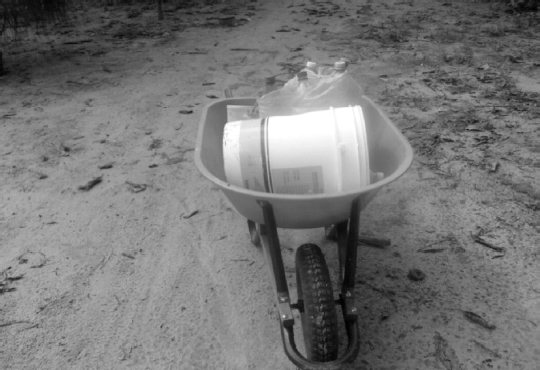 Source: Rafaela Sales de Sousa, 2015
Source: Rafaela Sales de Sousa, 2015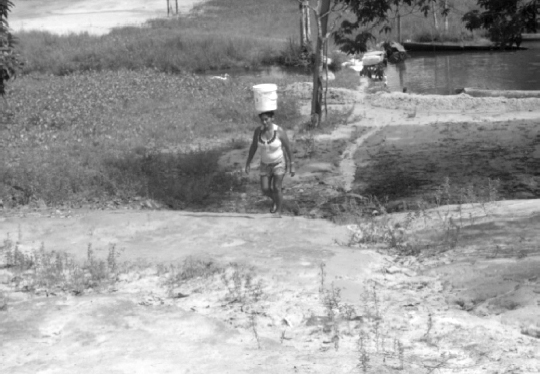 Source: Rafaela Sales de Sousa, 2015
Source: Rafaela Sales de Sousa, 2015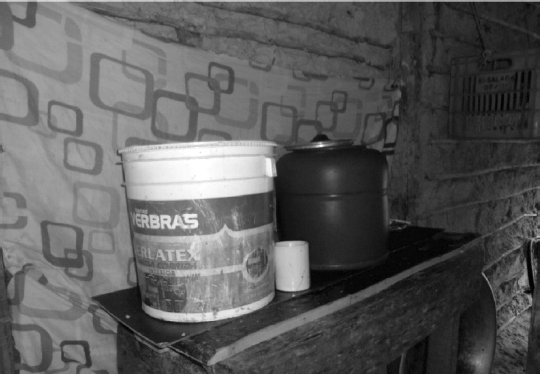 Source: Rafaela Sales de Sousa, 2015
Source: Rafaela Sales de Sousa, 2015